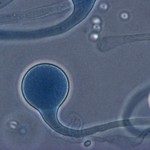Lien vers Pubmed [PMID] – 29077791
Clin. Infect. Dis. 2018 Mar;66(6):825-832
Background: Prosthetic valve endocarditis caused by Candida spp. (PVE-C) is rare and devastating, with international guidelines based on expert recommendations supporting the combination of surgery and subsequent azole treatment.
Methods: We retrospectively analyzed PVE-C cases collected in Spain and France between 2001 and 2015, with a focus on management and outcome.
Results: Forty-six cases were followed up for a median of 9 months. Twenty-two patients (48%) had a history of endocarditis, 30 cases (65%) were nosocomial or healthcare related, and 9 (20%) patients were intravenous drug users. “Induction” therapy consisted mainly of liposomal amphotericin B (L-amB)-based (n = 21) or echinocandin-based therapy (n = 13). Overall, 19 patients (41%) were operated on. Patients <66 years old and without cardiac failure were more likely to undergo cardiac surgery (adjusted odds ratios [aORs], 6.80 [95% confidence interval [CI], 1.59-29.13] and 10.92 [1.15-104.06], respectively). Surgery was not associated with better survival rates at 6 months. Patients who received L-amB alone had a better 6-month survival rate than those who received an echinocandin alone (aOR, 13.52; 95% CI, 1.03-838.10). “Maintenance” fluconazole therapy, prescribed in 21 patients for a median duration of 13 months (range, 2-84 months), led to minor adverse effects.
Conclusion: L-amB induction treatment improves survival in patients with PVE-C. Medical treatment followed by long-term maintenance fluconazole may be the best treatment option for frail patients.




